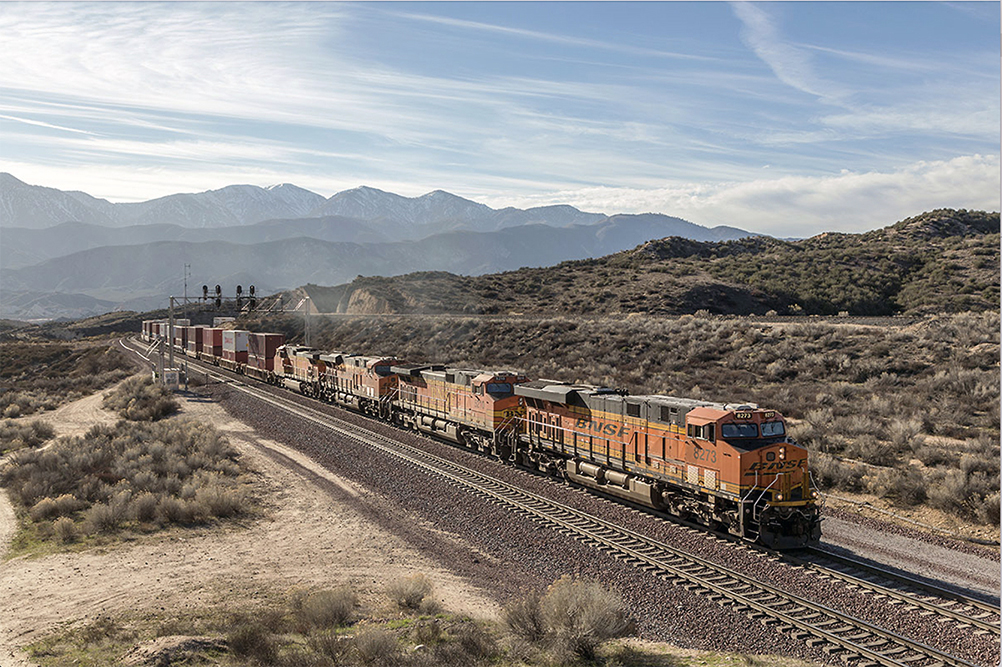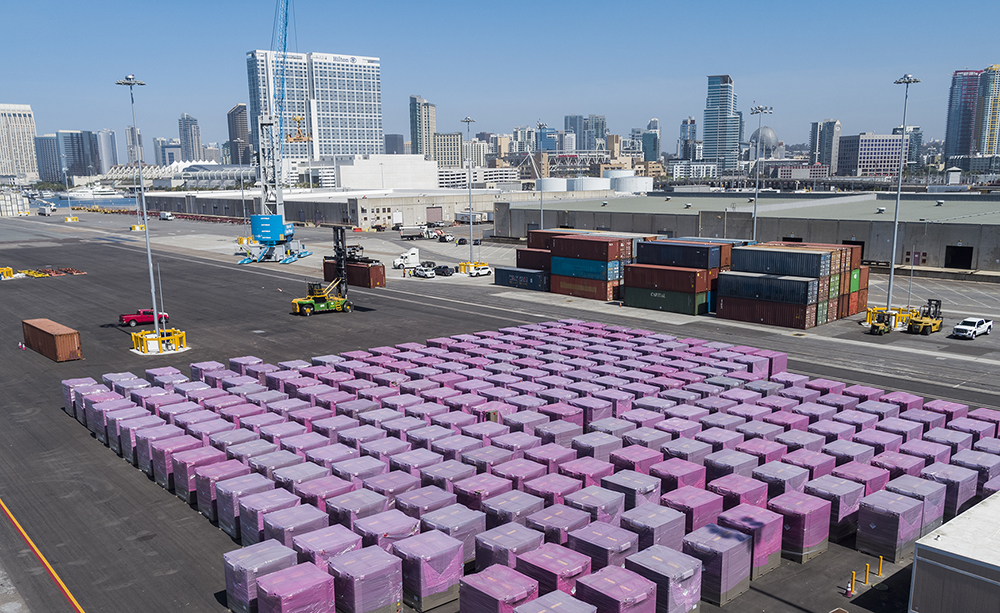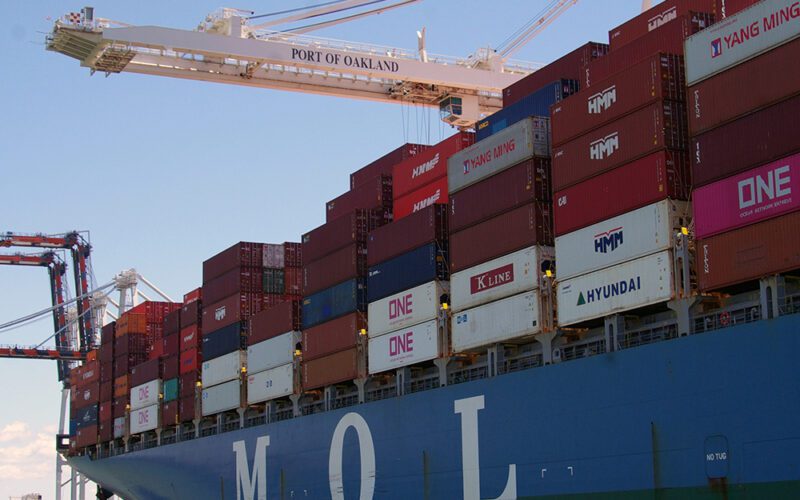
2022 was a wild ride for most major California seaports.
The Golden State is home to the nation’s busiest seaports, the Port of Los Angeles and the Port of Long Beach, which both have seen congestion-inducing record influxes of cargo, but also drops in market share as consumers emerge from the pandemic to spend their money on services rather than products.
The Port of Oakland and Port of San Diego have also seen growth in cargo numbers as both are seen as local alternatives to congested ports.
Retaining that market share has been further complicated by outside factors, from COVID-19-related factory closures in China to labor issues.
Despite those factors, however, private and public sectors continue to invest in California seaports. For example, Japan-based shipping firm Ocean Network Express (ONE) announced on Dec. 27 that it has inked agreements to acquire a 51% stake in TraPac LLC and Yusen Terminals. TraPac offers container terminal services in L.A. and Oakland, while Yusen provides container terminal services in Los Angeles.
Meanwhile, federal and state governments are pouring millions into California port projects. In late October, the Maritime Administration awarded $30.1 million in funding for the Middle Harbor Terminal Zero Emission Conversion Project in Long Beach and $36.5 million for the Outer Harbor Terminal Redevelopment Project in Oakland, among other projects.
“California’s ports play a critical role in keeping our global economy moving, supporting a vibrant workforce and advancing the state’s climate goals,” said California Association of Port Authorities President Danny Wan, who is also executive director of the Port of Oakland. “This investment will help to modernize our California port system and speed the transition to a clean energy economy while relieving congestion.”
Here’s a look at the state of the maritime industry at California’s major seaports.

Port of Los Angeles
In late 2022, Port of LA Executive Director Gene Seroka reflected on what was an eventful year for the seaport. It began with 109 ships waiting for berths and filled terminals. However, by August, even with record volume, 90% of the backlog had been eliminated, he said.
The amount of older cargo lingering at both Los Angeles and Long Beach declined so much that commissioners from both ports decided to phase out the “Container Dwell Fee” after Jan. 24. Ocean carriers would have been charged for cargo staying on the docks past nine days.
“In fact, we hit new productivity levels on our docks this year, averaging an exchange of 12,000 TEUs per ship call,” Seroka said in December. “That’s cargo loaded on and unloaded from every vessel that comes in, and that beats our previous record set just last year. We also broke cargo records five out of the first seven months this year. It wasn’t until late summer that we began to see the decline that continues today.”
The port moved about 639,000 TEUs in cargo in November, a 21% drop from 2021 and a 24% decrease compared to its five-year average. Imports were down 24% year over year, and while exports rose 9% from November 2021, it’s still 34% lower than its five-year average, Seroka said.
The port is attributing the slowdown to an early peak season and a shift to other ports due to labor talks between West Coast dockworkers and their managers.
Heading into 2023, Seroka said the port is focused on recapturing cargo, expanding data efforts and building infrastructure, while continuing to create more jobs and lead the industry to a zero-emission future.
“First, we’ve got to get this labor contract done,” Seroka said in December. “Both sides are working hard and I remain optimistic that these very capable negotiators are going to get to an agreement together early next year.”
Seroka also said that the port needs to get out and work for every pound of freight, just like when the agency partnered with stakeholders to clear the backlog.
“We need a united industry push to demonstrate why L.A. should be our customers’ first choice,” he said. “I’ve personally been on a whistle-stop tour, crisscrossing the country during these past six weeks, and I will continue to do so.”
Seroka said he wants to improve the port’s game with better data so that there’s less wait time and more efficiency.
Meanwhile, Los Angeles is working on various projects to bolster market share. The port is building a new marine oil platform at the Shell Oil Terminal, a $44.8-million project that calls for demolishing timber wharves and building and operating a new wharf that’s MOTEMS-compliant (Marine Oil Terminal Engineering and Maintenance Standards) at Berth 168, as well as small infrastructure improvements to link the new loading platform to current landside pipelines and utilities. The first phase of the project is expected to be finished in early 2023 and the whole project done in 2024.
The port is also looking to expand its Pier 400 rail-storage yard in an effort to meet future rail volume demand on Terminal Island. The $72.3-million project includes a concrete rail bridge with lighting, a half-dozen new railroad storage tracks, an asphalt access roadway, new crossovers and switches and modifications to the Pier 400 Rail Storage Yard and Bridge’s compressed air system.
Part of the Pier 400 lead track onto port property would have to be relocated and the track connecting to the rail-storage yard would have to be realigned, among other work, the port said. The project’s completion is expected in 2024.
There are also plans to design the $150 million Port of Los Angeles and Port of Long Beach Goods Movement Workforce Training Facility, billed as the nation’s first training center dedicated to the goods movement industry.
According to the port, the facility would simulate “goods movement environments, such as marine cargo terminals, providing a safe training environment for workers,” Officials also said that the new building seeks to offer regional workers “skills to succeed in careers that utilize new and cleaner human operated technologies.”
Design of the facility is being planned for mid-2023, according to the port.
Port of Long Beach
Like Los Angeles, the adjoining Port of Long Beach also experienced supply chain ups and downs from the prior White House administration’s tariffs to import surges brought on by the COVID-19 pandemic and resulting congestion.
By the second half of 2022, the Port of Long Beach began to see some semblance of normalcy, according to Executive Director Mario Cordero.
“I think just for the Port of Long Beach, you’re seeing now the fluidity of cargo, the dwell time now going back to a normal level that is pre-pandemic,” he said.
Cordero lauded the level of collaboration among stakeholders primarily led by the White House Envoy, Retired U.S. Army Gen. Stephen R. Lyons.
“I think that the synergy that we have here in the San Pedro Bay complex was a big factor in trying to tackle at least those factors that were within our control to address the surge that we experienced,” he said.
Cordero emphasized that cargo continues to move in the midst of West Coast labor negotiations.
“Labor has worked around the clock, so to speak, so as a result, the workforce keeps the cargo moving,” he said. “I do expect some meeting of the minds hopefully at the beginning of (2023).”
Cordero also said he’s attentive to the port’s dual mandate of meeting cargo demand and doing it in an environmentally forward way.
“One of the focuses for 2023 is to work on our lessons learned (from the last two years) and how do we transform our operations?” Cordero said.
He touted the port’s sustainability efforts, a commitment that dates back to 2005 with the announcement of its Green Port Policy. To date, the port has received more than $100 million in grants since the implementation of the Clean Air Action Plan, money to help meet the port’s zero-emission goals.
“That’s been a great success story,” he said. “Now, is it enough money to accomplish all that we need to do by 2030? No, but certainly it is a significant start in terms of (what we’re) able
to achieve.”
Cordero said he sees opportunity in the port’s participation in the Alliance for Renewable Clean Hydrogen Energy Systems (ARCHES), a group of public and private sector partners that seeks to capture federal funds to help nurture California’s renewable hydrogen market.
He sees hydrogen fuel as a solution for heavy-duty trucks in the coming years.
“This is going to be a very exciting topic ongoing in 2023 for the port to work with ARCHES and the state of California … to make sure we position ourselves for the eight-year plan, so to speak, of how our nation, and more specifically the state of California, moves forward to position ourselves to not only invest in infrastructure, but have renewable hydrogen,” he said.
Cordero also touted the Pier B On-Dock Rail Support Facility Project, a key part of the port’s rail capital improvement program. When completed, the facility would allow the port to move more of the cargo that would normally leave the docks by truck onto trains instead.
The locomotive facility project, which calls for building a functional 10,000-foot-long track, is expected to finish in 2025. More tracks are set to come online in 2030. The full project could be complete by 2032, according to the port.
In January 2022, U.S. Transportation Secretary Pete Buttigieg announced a $52-million grant for the project.
“That tells you how significant this project is, not only to the Port of Long Beach, not only to the region here in Southern California, but to the nation,” Cordero said.
He added how the port project parallels BNSF’s plans to build its Barstow International Gateway, a project that calls for a new 4,500-acre integrated rail facility with railyard, intermodal operations and warehouses for transloading international and domestic freight.
“The facility will allow the direct transfer of containers from ships at the ports of Los Angeles and Long Beach to trains for transport through the Alameda Corridor onto the BNSF mainline up to Barstow,” according to the railway.
Paired with BNSF’s project, the Pier B project will be a game changer for the port, Cordero said.
“I am extremely optimistic that at the end of the decade, we are going to be very well positioned and committed to our goal of not only zero emissions, but furthering cargo velocity as opposed to talking about cargo volatility that we’ve been addressing in the last couple of years as a nation,” he said.
Port of Oakland
The Port of Oakland weathered ups and downs in cargo volumes last year. It began with an upswing—more import volumes year over year—building on the record year of 2021 when it moved one million imported containers.
But the seaport also saw fewer container ships visit Oakland, with carriers putting more boxes on fewer vessels and sailing delays at Southern California seaports that forced shifts from Oakland.
As a result, Oakland saw exports numbers fall because exporters couldn’t find enough space on ships to send products abroad.
The port worked to improve the movement of agricultural exports, partnering with federal and state agencies to offer a temporary 25-acre off-terminal container yard that opened last March, allowing exports to come off chassis and be stored for quick pickups, as well as access to equipment for quicker turn times.
Factory and port closures in China to curb the spread of COVID-19 also affected Oakland. The impact on ocean carrier scheduling contributed to declining cargo volumes in April. China is Oakland’s biggest trade partner and the closures in Shanghai delayed imports to the U.S.
Then in July, terminals in Oakland shut down for nearly a week while hundreds of truck drivers protested the implementation of AB5, a state law mandating stronger language for labeling workers as independent contractors.
Data released Dec. 28 showed that Oakland’s overall cargo volumes in November fell 15% year over year, with full imports down 17.4% and exports down 12.3% when compared to November 2021. The changes were due to softer demand, falling ocean rates, canceled sailings and delays in the introduction of new services.
The port expected the decline, Maritime Director Bryan Brandes said in December.
“Despite October gains, long-term indicators continue to predict a decline in demand for goods,” he said. “The good news is that the reduction of incoming containers has allowed us to begin alleviating congestion at port facilities, increasing efficiencies in port operations.”
Meanwhile, Oakland continues to work on business expansion projects.
The port and the U.S. Army Corps of Engineers San Francisco District are partnering on a proposal to widen Oakland’s federal turning basins. The port expects a draft Environmental Impact Report to be completed early this year for public review. The port has set aside almost 10 acres of the Howard Terminal for expanding the Inner Harbor turning basin.
Depending on approvals and funding, designs for the turning basins plan could begin in late 2023, the port said last spring.
Last December, the port announced that the California Transportation Commission approved $175 million toward the Seventh Street Grade Separation East Project, which involves realigning and reconstructing a trucking and access gateway into the port that is expected to ease truck and vehicle congestion, bolster safety and offer more flexibility for cargo movement.
The funding “allows us to move this critical project into construction in 2023 and is a great example of (a) partnership to leverage local, regional and state funding to deliver transportation improvements that benefit not only the residents of Alameda County, but the entire Northern California mega-region,” Alameda CTC Executive Director Tess Lengyel said.

Port of San Diego
San Diego’s seaport says its data show growth in its breakbulk, dry bulk, liquid bulk and container cargo in fiscal year 2022, with breakbulk cargo up 73.8% with 133,750 metric tons, dry bulk up 10.4% with 644,635 metric tons, liquid bulk up 98.5% with 89,311 metric tons and containers up 10% with 1,038,302 metric tons.
However, the port saw its vehicle import numbers drop by 4% in FY 2022 with 526,425 metric tons.
While other ports have felt the impact of labor talks between West Coast dockworkers and their managers, San Diego has reported no labor issues. Greg Borossay, the port’s principal of Maritime Business Development, added that “because of our growth this year, we’ve supplemented our labor with travelers from the ports of Los Angeles/Long Beach.”
Borossay highlighted San Diego’s other successes, including advancing the National City Balanced Plan, which includes bolstering rail efficiencies and connector track at the National City Marine Terminal, as well as installing shore power and a bonnet system to capture harmful air emissions.
The port also noted the purchase of two all-electric cranes that are set to arrive in July and be operational by October.
“We are looking forward to the delivery and installation of the all-electric, dual-lift crane system for the Tenth Avenue Marine Terminal,” Borossay said. “These two cranes, when working in tandem, will…be able to lift 400 megatons together.”
Borossay also touted the port’s cruise business thus far, with more than 140 cruises on schedule for the season, running from September to May 2023. While Disney Cruise Line has more than doubled its bookings from San Diego, Princess Cruises has signed on as a homeport for the first time since 2006.
In the coming years, the port plans to extend its existing contracts to secure business acquired during the post-COVID period, specifically shipping companies G2, Saga Welco and U.S. Ocean, he said.
San Diego is also looking at extension of contracts for some of the bulk carriers.
“There is also the possibility of obtaining some incremental growth with some of our existing carriers,” Borossay added.
The port has been promoting the Free Trade Zone program at its Tenth Avenue Marine Terminal as a way to attract business.
“This program is very helpful for shippers looking to re-shore their supply chains, bringing back their supply chains from China to America,” Borossay said. “The FTZ can be used to expedite merchandise/commerce. Shippers can use this to reduce or defer duties and save time and money. The port’s FTZ is the only maritime access site in San Diego County. Cargo types are container, breakbulk, automotive components and solar racking.”
Greening the port is also a major focus.
The Board of Port Commissioners in October 2021 approved a Maritime Clean Air Strategy, a policy document that identifies and prioritizes projects to lower air emissions and improve air quality.
A big part of that strategy involves working on a preliminary Heavy Duty Truck Transition Plan laying out how the port will reach a key strategy goal of transitioning 40% of cargo trucks calling on the San Diego port to zero emissions by June 30, 2026, and 100% of trucks to be zero emissions by 2030.
Installing additional shore power equipment at cruise ship terminals is a focus for San Diego. “Currently we have capacity for only one vessel to plug into shore power at a time,” Borossay said. “The additional equipment will allow for two to plug in at the same time.”
The additional shore power system is expected to be done by the end of this year, he said.
The port also plans to put in a microgrid, battery-storage system, and electrical infrastructure at its Tenth Avenue Marine Terminal.
“The microgrid will provide back-up power to port-operated facilities, including security infrastructure, lights, offices and the existing jet-fuel storage system in support of the port’s role as a strategic port,” Borossay said.
KAREN ROBES MEEKS, a Southern California native, is an award-winning journalist with more than 20 years’ writing experience. Her articles have appeared in the Los Angeles Times, San Francisco Chronicle, Orange County Register and Long Beach Press-Telegram, where she worked as a reporter for nearly 14 years. Her work has been recognized by the California News Publishers Association, the Associated Press News Executives Council and the Los Angeles Press Club. She can be reached at karen@maritimepublishing.com

